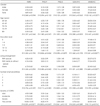1. Lee KS. An analysis of the situation of health care sysyem for aging society. Hanyang Univ J Aging Soc. 2011. 2:1–28.
2. 2011 Statistics of the Aged. kostat.go.kr [hompage on the Internet]. updated 2012 Sep 27; cited 2013 Apr 14. Available from:
http://kostat.go.kr/.
3. Suh GH, Choi IG, Cho MJ, Cho DY, Rhoo IK, Yeon BK. Prevalence and risk factors of depressive symptomatology among the Korean elderly. J Korean Geriatr Soc. 1998. 2:49–60.
4. Korean Association for Geriatric Psychiatry. Geriatric psychiatry. 2004. 2nd ed. Seoul: Jungang moonhwa;197–210.
5. Bahk WM, Min KJ. Textbook of depressive disorders. 2012. 1st ed. Seoul: Sigmapress;151–152.
6. Zung WW, Magruder-Habib K, Velez R, Alling W. The comorbidity of anxiety and depression in general medical patients: a longitudinal study. J Clin Psychiatry. 1990. 51:Suppl. 77–80. discussion 81.
7. Kunik ME, Roundy K, Veazey C, Souchek J, Richardson P, Wray NP, et al. Surprisingly high prevalence of anxiety and depression in chronic breathing disorders. Chest. 2005. 127:1205–1211.

8. Musselman DL, Lawson DH, Gumnick JF, Manatunga AK, Penna S, Goodkin RS, et al. Paroxetine for the prevention of depression induced by high-dose interferon alfa. N Engl J Med. 2001. 344:961–966.

9. Rudisch B, Nemeroff CB. Epidemiology of comorbid coronary artery disease and depression. Biol Psychiatry. 2003. 54:227–240.

10. Cleland JA, Lee AJ, Hall S. Associations of depression and anxiety with gender, age, health-related quality of life and symptoms in primary care COPD patients. Fam Pract. 2007. 24:217–223.

11. Robinson RG. Poststroke depression: prevalence, diagnosis, treatment, and disease progression. Biol Psychiatry. 2003. 54:376–387.

12. Goldney RD, Ruffin R, Fisher LJ, Wilson DH. Asthma symptoms associated with depression and lower quality of life: a population survey. Med J Aust. 2003. 178:437–441.

13. Chun TH, Weitzen SH, Fritz GK. The asthma/mental health nexus in a population-based sample of the United States. Chest. 2008. 134:1176–1182.

14. Hwang YI, Kim HJ, Won WY, Joh JS, Oh YM, Jung KS, et al. Screening for depression in patients with chronic obstructive pulmonary disease: a systematic review. Korean J Med. 2012. 83:468–475.

15. Crockett AJ, Cranston JM, Moss JR, Alpers JH. The impact of anxiety, depression and living alone in chronic obstructive pulmonary disease. Qual Life Res. 2002. 11:309–316.
16. Hamilton M. A rating scale for depression. J Neurol Neurosurg Psychiatry. 1960. 23:56–62.

17. Yi JS, Bae SO, Ahn YM, Park DB, Noh KS, Shin HK, et al. Validity and reliability of the Korean version of the Hamilton Depression Rating Scale (K-HDRS). J Korean Neuropsychiatr Assoc. 2005. 44:456–465.
18. Kroenke K, Spitzer RL, Williams JB. The PHQ-9: validity of a brief depression severity measure. J Gen Intern Med. 2001. 16:606–613.
19. Choi HS, Choi JH, Park KH, Joo KJ, Ga H, Ko HJ, et al. Standardization of the Korean version of patient health questionnaire-9 as a screening instrument for major depressive disorder. J Korean Acad Fam Med. 2007. 28:114–119.
20. Kroenke K, Spitzer RL, Williams JB. The Patient Health Questionnaire-2: validity of a two-item depression screener. Med Care. 2003. 41:1284–1292.
21. Yesavage JA, Brink TL, Rose TL, Lum O, Huang V, Adey M, et al. Development and validation of a geriatric depression screening scale: a preliminary report. J Psychiatr Res. 1982-1983. 17:37–49.

22. Bae JN, Cho MJ. Development of the Korean version of the Geriatric Depression Scale and its short form among elderly psychiatric patients. J Psychosom Res. 2004. 57:297–305.

23. Lee JH, Lee KU, Lee DY, Kim KW, Jhoo JH, Kim JH, et al. Development of the Korean version of the Consortium to Establish a Registry for Alzheimer's Disease Assessment Packet (CERAD-K): clinical and neuropsychological assessment batteries. J Gerontol B Psychol Sci Soc Sci. 2002. 57:P47–P53.

24. Lee YH, Shin MH, Kweon SS, Choi SW, Ryu SY, Rhee JA, et al. Prevalence and correlates of depression among the elderly in an urban community. J Agric Med Community Health. 2008. 33:303–315.

25. Cho MJ, Kim KH. Diagnostic validity of the CES-D(Korean version) in the assessment of DSM-III-R major depression. J Korean Neuropsychiatr Assoc. 1993. 32:381–399.
26. Kim SY, Ko SG, Kwon JH. The moderating effect of social support and coping on widowed elderly. Korean J Clin Psychol. 2007. 26:573–596.

27. Kim SY, Kim SG, Seo HJ. Depression and Resilience in Late Life Widowhood: Testing Mediation Model of Social Support. Health Soc Welf Rev. 2011. 31:165–196.

28. Egede LE. Major depression in individuals with chronic medical disorders: prevalence, correlates and association with health resource utilization, lost productivity and functional disability. Gen Hosp Psychiatry. 2007. 29:409–416.

29. Kim JM, Kim SW, Yang SJ, Kim SY, Bae KY, Cho JY, et al. Prospective Associations between Physical Disorders and Insomnia in Elders. J Korean Neuropsychiatr Assoc. 2008. 47:488–492.
30. Jones PW. Depression in chronic obstructive pulmonary disease: a common concomitant disease. Am J Respir Crit Care Med. 2011. 183:562–563.

31. van Manen JG, Bindels PJ, Dekker FW, IJzermans CJ, van der Zee JS, Schadé E. Risk of depression in patients with chronic obstructive pulmonary disease and its determinants. Thorax. 2002. 57:412–416.

32. Horita N, Kaneko T, Shinkai M, Yomota M, Morita S, Rubin BK, et al. Depression in Japanese Patients with Chronic Obstructive Pulmonary Disease. A Cross-Sectional Study. Respir Care. 2013. [Epub ahead of print].

33. Lyketsos CG, Steele C, Baker L, Galik E, Kopunek S, Steinberg M, et al. Major and minor depression in Alzheimer's disease: prevalence and impact. J Neuropsychiatry Clin Neurosci. 1997. 9:556–561.










 PDF
PDF ePub
ePub Citation
Citation Print
Print



 XML Download
XML Download